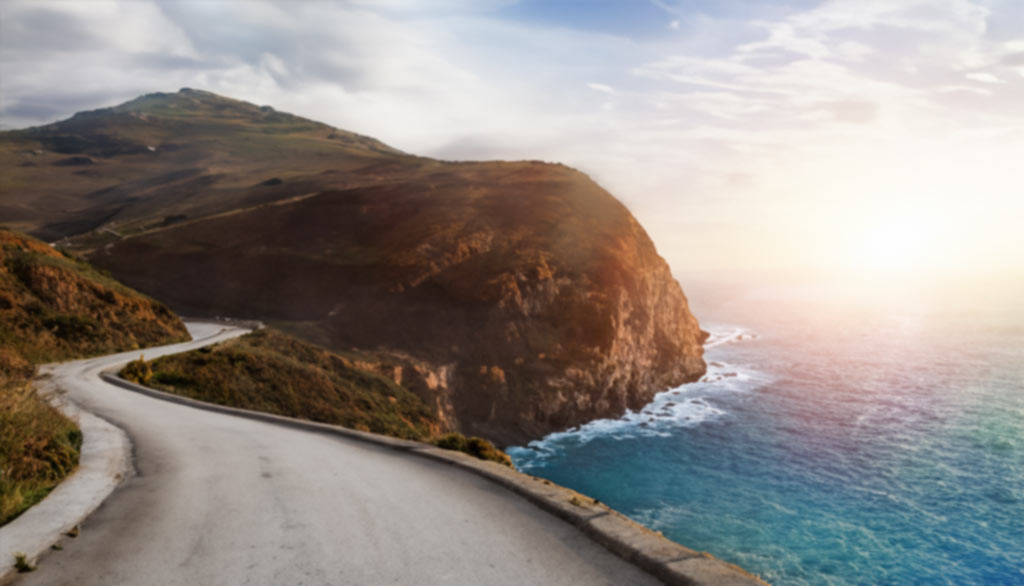
Tourists can get to Crete via ferry from mainland Greece and several nearby islands. The main routes connect Piraeus to the Port of Heraklion and the Port of Souda Bay. Seasonal ferries link Crete with Santorini, Paros, Naxos, Mykonos, Milos, Rhodes, Karpathos, Kythira, Kos, and other destinations. Ferry routes to Crete sail at least once daily to several times weekly, depending on the season and operator. The travel time ranges from 1 hour and 45 minutes to 16 hours and 30 minutes. Distances vary from 63 nautical miles (117 kilometers, 73 miles) to 210 nautical miles (389 kilometers, 242 miles). The cost of ferry tickets to Crete typically ranges from €20–€100 (£17–£85), depending on the route, vessel type, and travel season. Major routes operate year-round, though some island connections run seasonally. Read article

Ferma Beach is a small, unorganized beach located on Crete’s southern coast, just 11.9 kilometers (7.4 miles) east of Ierapetra. The beach is cherished for its peaceful setting, natural shade from shoreline reeds, and consistently calm, warm waters, ideal for travelers desiring a quiet alternative to busier resorts. Ferma has a sandy shoreline, surrounded by scattered rocks and caves, making it a popular spot for swimming, snorkeling, and light exploration. The translucent waters, gradual depth, and lack of crowds make it especially suitable for families and casual swimmers. Read article

Aradena Gorge is one of Crete’s most dramatic Gorge natural landmarks, stretching 15 kilometres (9,32 miles) from the abandoned village of Aradena to the secluded Marmara Beach on the island’s southern coast. Aradena Canyon was formed through millennia of erosion and tectonic activity, and offers a challenging but rewarding hiking experience, featuring steep descents, narrow passages, and vertical drops aided by metal ladders. Read article
Panormos Beach is a quiet, family-friendly destination located 21.6 kilometers (13.4 miles) east of Rethymno on Crete’s northern coast. Panormos beach is set in a natural harbor and features soft, golden sand and calm, shallow waters suitable for swimming, paddleboarding, and relaxation. Its wind-protected setting and proximity to the traditional village of Panormos create a peaceful environment for visitors of all ages. Panormos name comes from the Greek word "Πάνορμος", which means "sheltered harbor". Panormos village is pronounced "PA-nor-mos" in English and written "Πάνορμος" in Greek. Panormos has a population of 500 residents. Panormos beach is partially organized with sun loungers, umbrellas, and basic amenities, while the village itself hosts tavernas, cafés, and small shops just steps away. Popular nearby attractions include Spillies Beach, Melidoni Cave and Varkotopos Beach. Read article
Vai Beach is one of the most iconic coastal attractions in eastern Crete, famous for its rare palm forest, soft golden sand, and clear blue waters. The beach is located 24.1 kilometers (15 miles) northeast of Sitia, offering an exotic landscape paired with organized facilities like sunbeds, umbrellas, and a canteen. Vai is accessible by car rental, with parking near the entrance and a short walking path to the shore. Visitors can enjoy swimming, sunbathing, and hiking to the nearby lookout point above the palm grove. Vai beach welcomes kids and pets and is free to enter year-round, making it ideal for all sorts of travelers. Read article
Agia Roumeli is a quiet, remote coastal spot on Crete’s southern coast, recognized for its dramatic scenery, black pebbled shoreline, and clean, refreshing waters. This beach offers a peaceful atmosphere far from heavy tourism and commercial noise, often visited by hikers completing the Samaria Gorge trail. Agia Roumeli Beach provides the perfect setting to swim, sunbathe, snorkel, or simply relax after a long hike, with sunbeds available in some areas and large stretches left natural and unorganized. The beach is only accessible by ferry or on foot, making it one of the most secluded destinations on the island. Visitors usually combine a scenic drive and short ferry ride from small ports like Hora Sfakion, Sougia, and Palaiochora to reach the village. Agia Roumeli is best visited between late June and early October when water temperatures are warm. Read article
Analipsi is a village on the northern coast of Crete, 21 kilometres (13,05 miles) east of Heraklion, the capital city. It lies in a valley with olive groves near the popular tourist area stretching from Kato Gouves to Anissaras. The history of Analipsi dates back to the period of Ottoman rule in Crete in the 1800s when a small settlement called "Svourou" or "Svourou Metohi" existed in the area. Shepherds from the Lasithi Plateau region started moving to this warmer area during the winter months to feed their animals, and they began building basic stone houses, forming the village. A church dedicated to the Ascension of Christ was established in 1896, giving the village its current name, "Analipsi" (meaning Ascension in Greek). Read article
Psaromoura Beach is a small, pebbled cove in northern Crete, offering a naturally enclosed setting with calm waters ideal for swimming and snorkeling. It is located within a rocky bay, shielding it from strong winds and creating a peaceful coastal retreat with clear, inviting waters. Psaromoura Beach attracts visitors seeking a quieter alternative to larger beaches, combining scenic surroundings with a more intimate seaside experience.Psaromoura Beach is located 22 kilometers (14 miles) northwest of Heraklion, near the seaside village of Agia Pelagia. The beach can be reached via a 25-minute drive from Heraklion, following the E75 highway toward Rethymno before taking the exit for Agia Pelagia. Read article

Travelers planning to drive in Crete must understand Greece’s license requirements. An International Driving Permit (IDP) is mandatory for drivers from non-EU or non-EEA countries such as the United States, Canada, and Australia. This document must accompany a valid domestic license and serves as its official translation.Rental Center Crete accepts licenses written in the Latin alphabet without an IDP, but most agencies in Greece require one. Visitors can apply for an IDP through authorized agencies in their home countries, such as AAA in the United States, the Post Office in the UK, and the CAA in Canada. Read article

The average cost of renting a car in Greece varies according to the vehicle type, rental term, season, and agency. Daily rates typically range between 18 € ($19.44, £15.47) and 49 € ($52.88, £42.10), with economy and compact cars offering the lowest prices. Longer rentals can lower daily costs to as little as 8 € ($8.64, £6.88) per day, especially during the off-season. March is the most cost-effective month, with the lowest rates across all vehicle categories. Some rental companies include hidden costs, but Rental Center Crete includes everything in the advertised price. This guide gives guests a comprehensive picture of how to budget for car rental throughout their stay in Greece. Read article

Seitan Limania Beach is one of Crete’s most visually dramatic and remote coastal spots, nestled in a narrow cove on the Akrotiri Peninsula, just 22.2 kilometers (14.1 miles) northeast of Chania, Seitan Limania, also called Agiou Stefanou beach, is a secluded beach that is accessible via a challenging downhill trail, and features a compact shoreline of coarse sand and pebbles surrounded by steep limestone cliffs and clear turquoise waters. Read article
Kastri Beach is a pebbly shore on Crete’s southern coast, located 60 kilometers (37.2 miles) from Heraklion. The beach is named after the nearby village of Kastri and is known for its glistening waters and relaxed atmosphere. Kastri Beach has loungers and umbrellas in some portions of its shoreline, while much of it remains unspoiled, allowing visitors to admire Crete’s natural beauty. Read article
Almyros Beach is located 2.5 km (1.5 mi.) from Agios Nikolaos in northeastern Crete. The beach is named after the Almyros River which flows directly into the sea, creating a mix of fresh and saltwater. The beach is ideal for families and nature enthusiasts with its shallow, clear waters and lush greenery. Facilities include sunbeds, umbrellas, and a beachside café. Read article
Tris Ekklisies Beach is a coastal attraction located 64 kilometers (39,76 miles) south of Heraklion in Crete. Tris Ekklisies is named after the three nearby churches and features fine golden sand, clear waters, and rugged cliffs. It's a peaceful escape from Crete’s more touristy spots, perfect for visitors seeking relaxation. The beach can be accessed by car, offering scenic views along the Asterousia Mountains, and is equipped with sun beds, umbrellas, and nearby tavernas. Read article
Psari Forada Beach is a coastal retreat in the fishing village of Sidonia in Crete, situated 74.8 km (46.5 miles) south of Heraklion. The beach features dark-colored sand and deep blue waters, providing a peaceful alternative to busier Crete beaches. Psari Forada is easily reachable via KTEL buses or cars and is ideal for swimming, snorkeling, and sunbathing. Read article
Kali Limenes Beach, known as Good Ports Beach or Kaloi Limenes, is a secluded coastal destination on Crete’s southern coast. Kali Limenes Beach lies 75 kilometers (46.6 miles) southwest of Heraklion, within the Asterousia Mountains, offering clear blue waters, a mix of fine sand and pebbles, and sheltered coves. The beach benefits from a natural wind barrier, ensuring calm swimming conditions for most of the year. Read article
Koutsouras Beach is a coastal destination on the southern coast of Crete, west of the village of Koutsouras. It features dark grey pebbles, clear blue waters, and natural shade from tamarisk trees. Koutsouras Beach is sheltered from strong northern winds, ensuring calm waters throughout the year and making it an ideal spot for swimming. The beach holds a Blue Flag certification, ensuring high environmental standards, cleanliness, and safety. Read article
Agios Charalambos Beach is a small, secluded beach 60 kilometers (37.3 miles) south of Chania and 1.5 kilometers (0.9 miles) east of Chora Sfakion, offering a peaceful retreat with clear blue waters and a natural landscape. It features a mixed seabed of fine pebbles and sand, with sunbeds, umbrellas, and a beachside taverna providing a comfortable seaside experience. Read article

Tertsa Beach is a coastal retreat 79 kilometers (49 miles) south of Heraklion in Crete. Tertsa is a tourist destination with coarse sands, turquoise waters, and fine pebbles, offering a quiet escape from the region’s more crowded attractions. The surrounding cliffs and hills enhance its untouched beauty, while a few sun loungers and traditional tavernas provide convenience without disrupting the beach’s natural charm. Read article

Samaria Gorge is one of Crete’s most iconic natural wonders, drawing hikers globally to experience its rugged beauty, rich history, and ecological significance. The gorge stretches 16 kilometers (9.9 miles) through the White Mountains in southwest Crete, and descends from the Omalos Plateau to the Libyan Sea at Agia Roumeli. Read article




























